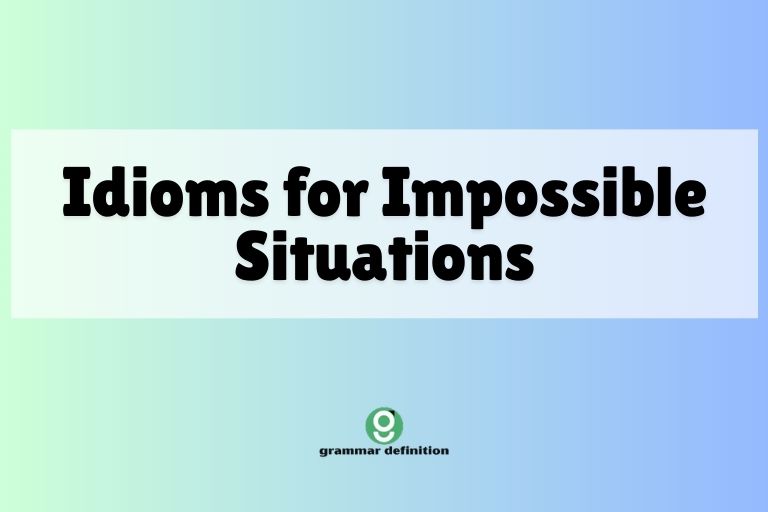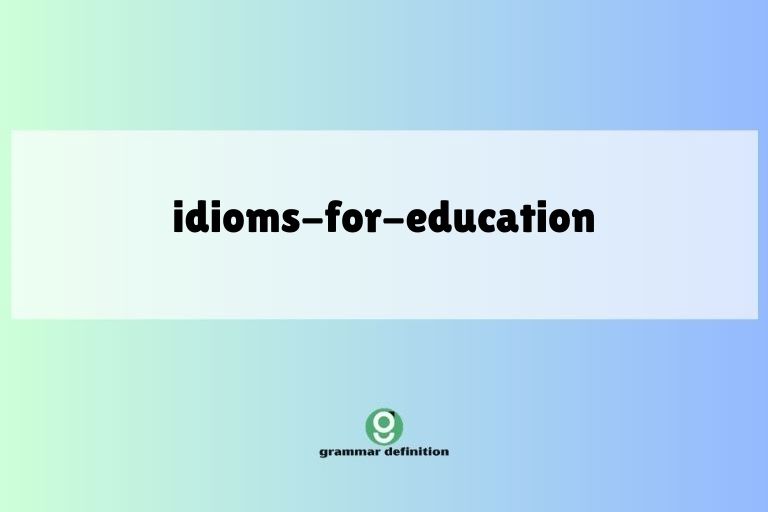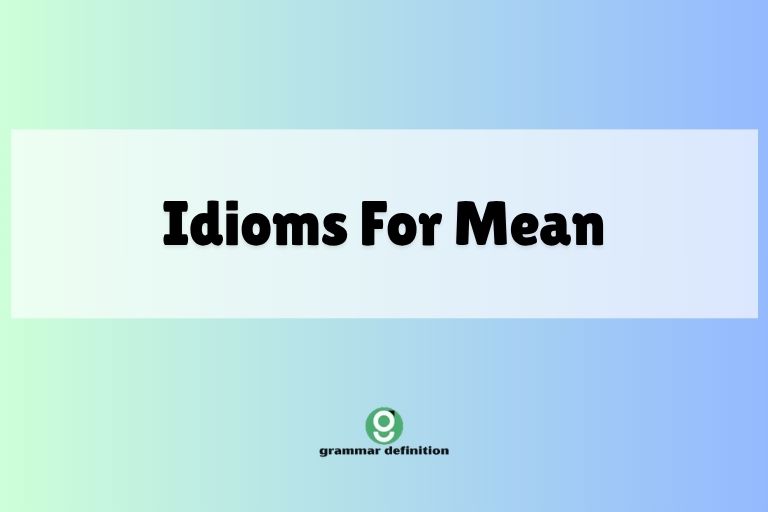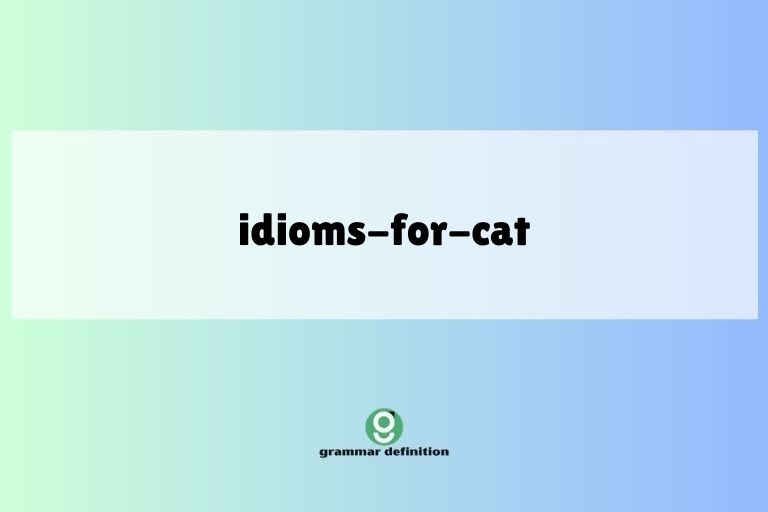Idioms for Clarity: Mastering Expressive English

Understanding and using idioms is crucial for mastering English, especially for achieving clarity and vividness in communication. Idioms are phrases or expressions whose meanings cannot be understood from the ordinary meanings of the words themselves.
They add color, nuance, and depth to language, making it more engaging and relatable. This article provides a comprehensive guide to idioms that convey clarity, helping English learners and speakers alike to express themselves more effectively and precisely.
Whether you’re preparing for an exam, aiming to improve your writing, or simply looking to enhance your everyday conversations, this guide will equip you with the knowledge and tools to confidently use idioms related to clarity.
Table of Contents
- Definition of Idioms for Clarity
- Structural Breakdown of Clarity Idioms
- Types and Categories of Clarity Idioms
- Examples of Clarity Idioms
- Usage Rules for Clarity Idioms
- Common Mistakes with Clarity Idioms
- Practice Exercises
- Advanced Topics in Clarity Idioms
- Frequently Asked Questions
- Conclusion
Definition of Idioms for Clarity
An idiom is a phrase or expression whose meaning is different from the literal meaning of the individual words within it. Idioms related to “clarity” are those that describe situations, ideas, or explanations that are easily understood, transparent, or free from ambiguity.
These idioms enhance communication by providing a concise and colorful way to express the concept of understanding or lack thereof. They can be used to describe a clear explanation, a transparent motive, or a straightforward situation.
The function of clarity idioms is to add emphasis and color to language, making it more vivid and relatable. They often convey a sense of certainty or obviousness, which can be more impactful than simply stating that something is “clear.” The contexts in which these idioms are used vary widely, from everyday conversations to formal writing, depending on the specific idiom and its level of formality.
Understanding the nuances of each idiom is crucial for using them effectively and appropriately.
Structural Breakdown of Clarity Idioms
Clarity idioms, like all idioms, do not follow standard grammatical rules in terms of their meaning. Instead, their meanings are derived from cultural understanding and common usage.
However, they still adhere to grammatical structures within the phrase itself. Most clarity idioms consist of a combination of nouns, verbs, adjectives, and prepositions, arranged in a way that creates a fixed expression.
The structure often contributes to the idiom’s figurative meaning.
For example, the idiom “clear as a bell” follows a simple structure: adjective + preposition + noun. The adjective “clear” is modified by the comparison to a “bell,” creating a vivid image of something easily heard and understood.
Similarly, “crystal clear” is an adjective phrase that intensifies the concept of clarity. The structural elements work together to create a meaning that is greater than the sum of their parts.
Types and Categories of Clarity Idioms
Clarity idioms can be categorized based on their specific meanings and the contexts in which they are typically used. Here are some common categories:
1. Transparency and Obviousness
These idioms describe situations or motives that are easily seen or understood, often implying a lack of hidden agendas.
2. Understandability and Comprehension
These idioms focus on the ease with which something can be understood, often referring to explanations or instructions.
3. Lack of Confusion
These idioms emphasize the absence of ambiguity or uncertainty, highlighting the clarity of a situation or statement.
4. Directness and Honesty
These idioms describe communication that is straightforward and without deception, emphasizing the clarity of intent.
5. Visual Clarity
These idioms relate to things that can be seen clearly, often used in a literal or figurative sense.
Examples of Clarity Idioms
Here are some examples of clarity idioms, categorized by their meaning. Each example is provided with a sentence to illustrate its usage and meaning.
Table 1: Transparency and Obviousness
The following table provides examples of idioms that describe situations or motives that are easily seen or understood, often implying a lack of hidden agendas. Understanding these idioms can help you to quickly identify when someone is being transparent or when a situation is obvious.
| Idiom | Meaning | Example Sentence |
|---|---|---|
| An open book | Someone whose thoughts and feelings are easily known. | She’s an open book; you always know what she’s thinking. |
| Clear as day | Very obvious or easy to understand. | It’s as clear as day that he’s in love with her. |
| Crystal clear | Extremely clear and easy to understand. | The instructions were crystal clear, so we had no trouble assembling the furniture. |
| Plain as the nose on your face | Very obvious or easy to see. | The solution was as plain as the nose on your face; I don’t know how I missed it. |
| See through someone | Understand someone’s true motives or intentions. | I can see right through him; he’s only being nice because he wants a favor. |
| Transparent as glass | Easy to see through, both literally and figuratively. | Her motives were as transparent as glass; she clearly wanted the promotion. |
| In broad daylight | Very obvious or public. | They committed the crime in broad daylight, right in front of the security camera. |
| Out in the open | Publicly known or discussed. | The issue is finally out in the open, and we can start addressing it. |
| Written all over one’s face | Very obvious from someone’s expression. | His disappointment was written all over his face when he didn’t get the job. |
| A dead giveaway | An obvious sign or clue. | The fact that he was sweating profusely was a dead giveaway that he was nervous. |
| On the surface | Apparent or obvious at first glance. | On the surface, everything seemed fine, but underneath there were problems. |
| Up front | Honest and straightforward. | He was very up front about his past mistakes during the interview. |
| No secret | Widely known and not hidden. | It’s no secret that she’s been working hard to get promoted. |
| An open secret | A fact that is widely known but not officially acknowledged. | Their affair was an open secret in the office. |
| Above board | Legitimate and honest. | The business deal was completely above board; everything was done by the book. |
| Straightforward | Direct and clear. | He gave a straightforward answer to the question. |
| On display | Easily visible or apparent. | Her talent was on display during the performance. |
| As plain as day | Very clear and easy to understand. | The instructions were as plain as day. |
| Lay bare | To reveal or expose something. | The investigation laid bare the corruption within the company. |
| In black and white | In writing or very clear and definite. | The agreement was in black and white, so there was no room for misunderstanding. |
Table 2: Understandability and Comprehension
This table provides examples of idioms focusing on the ease with which something can be understood, often referring to explanations or instructions. These idioms are useful for describing how well information is conveyed and received.
| Idiom | Meaning | Example Sentence |
|---|---|---|
| Get the picture | Understand the situation or information. | I think I get the picture; you want me to handle the presentation. |
| Make sense of | Understand something that is confusing or complicated. | I couldn’t make sense of the instructions, so I asked for help. |
| See the light | Finally understand something after a period of confusion. | After hours of debate, he finally saw the light and agreed with our proposal. |
| Sink in | Be fully understood or realized. | It took a while for the news to sink in; I was in shock. |
| Click into place | Become clear or understandable. | Once he explained the concept, everything clicked into place. |
| Get the drift | Understand the general meaning or idea. | I didn’t understand all the details, but I got the drift of his argument. |
| In layman’s terms | Explained in simple, non-technical language. | The doctor explained the procedure in layman’s terms so I could understand it. |
| Spell out | Explain something in very clear and detailed terms. | I had to spell out the instructions for him because he wasn’t paying attention. |
| Dawn on someone | Become clear to someone suddenly. | It suddenly dawned on me that I had forgotten my keys. |
| Grasp the nettle | To tackle a difficult task or problem directly. | We need to grasp the nettle and address the budget issues head-on. |
| Piece together | To assemble or understand something by combining different elements or information. | The detective had to piece together the events of the night to solve the crime. |
| Add up | To make sense or be consistent. | His story didn’t add up, and I suspected he was lying. |
| Figure out | To understand or solve a problem. | I need to figure out how to fix this computer. |
| Get through to someone | To make someone understand something. | I tried to get through to him, but he wouldn’t listen. |
| Wrap one’s head around | To understand something complicated. | I’m trying to wrap my head around this new software. |
| Put two and two together | To deduce something from the information available. | She put two and two together and realized he was planning a surprise party. |
| Get the hang of something | To learn how to do something. | It took me a while, but I finally got the hang of the new system. |
| Follow suit | To do the same thing as someone else. | Once he understood the plan, the others followed suit. |
| Read between the lines | To understand the hidden meaning behind words. | You have to read between the lines to understand what she really meant. |
| Get your head around | To understand something complicated. | I can’t seem to get my head around this new concept. |
Table 3: Lack of Confusion
The following table illustrates idioms that emphasize the absence of ambiguity or uncertainty, highlighting the clarity of a situation or statement. These idioms are used to describe situations where there is no room for misinterpretation.
| Idiom | Meaning | Example Sentence |
|---|---|---|
| Cut and dried | Completely settled or decided. | The decision is cut and dried; we’re moving forward with the project. |
| No room for doubt | Completely certain or without question. | There’s no room for doubt; he’s the best candidate for the job. |
| Leave no stone unturned | To do everything possible to find something or solve a problem. | The detectives left no stone unturned in their investigation. |
| Beyond question | Undeniable or certain. | Her talent is beyond question; she’s an exceptional artist. |
| Set in stone | Fixed and unchangeable. | The deadline is set in stone; we can’t move it. |
| Clear-cut | Clearly defined or easy to understand. | The rules are clear-cut; there’s no room for interpretation. |
| In no uncertain terms | Very clearly and directly. | She told him in no uncertain terms that she was not interested. |
| Free from ambiguity | Without any possibility of multiple interpretations. | The contract was written to be free from ambiguity. |
| Point-blank | Directly and without hesitation. | She asked him point-blank if he was cheating on her. |
| Without a shadow of a doubt | Absolutely certain. | I know without a shadow of a doubt that she’s the right person for the job. |
| As sure as eggs is eggs | Absolutely certain. | You can rely on him, as sure as eggs is eggs. |
| No ifs, ands, or buts | Without any exceptions or conditions. | You have to finish this by tomorrow, no ifs, ands, or buts. |
| Leave no room for error | To ensure that there is no possibility of mistakes. | The process was designed to leave no room for error. |
| Unmistakable | Clear and obvious. | The signs of his nervousness were unmistakable. |
| Definitive | Final and conclusive. | The court’s decision was definitive. |
| Unequivocal | Clear and leaving no doubt. | Her answer was unequivocal. |
| Beyond a reasonable doubt | The standard of proof required to convict a criminal defendant in a criminal trial. | The jury found him guilty beyond a reasonable doubt. |
| Not mince words | To speak directly and frankly. | She didn’t mince words when she told him what she thought. |
| Get to the point | To speak directly about the most important thing. | Just get to the point; I don’t have much time. |
| Straight from the shoulder | Direct and honest. | He gave me a straight-from-the-shoulder answer. |
Table 4: Directness and Honesty
This table provides idioms that describe communication that is straightforward and without deception, emphasizing the clarity of intent. These idioms are useful for describing how honest and upfront someone is being.
| Idiom | Meaning | Example Sentence |
|---|---|---|
| Call a spade a spade | Speak frankly and directly, without euphemisms. | Let’s call a spade a spade; this project is a failure. |
| Get something off your chest | Confess something that has been bothering you. | I need to get something off my chest; I’ve been lying to you. |
| Lay your cards on the table | Be open and honest about your intentions. | I’m going to lay my cards on the table; I want to be your partner. |
| Come clean | Confess or admit to something. | He decided to come clean about his past mistakes. |
| Shoot from the hip | Speak frankly and without thinking too much about the consequences. | He tends to shoot from the hip, which can sometimes offend people. |
| Beating around the bush | Avoiding the main point by talking indirectly. | Stop beating around the bush and tell me what you really want. |
| Level with someone | Be honest and straightforward with someone. | I’m going to level with you; we’re in serious trouble. |
| Straight shooter | A person who is honest and direct. | He’s a straight shooter; you can always trust what he says. |
| Tell it like it is | Describe something honestly, even if it’s unpleasant. | He always tells it like it is, which can be refreshing. |
| On the level | Honest and genuine. | You can trust him; he’s on the level. |
| Above-board | Honest and legal. | The deal was completely above-board. |
| In good faith | Honestly and sincerely. | We negotiated the contract in good faith. |
| From the heart | Sincere and heartfelt. | He spoke from the heart during his speech. |
| No holds barred | Without any restrictions or limitations. | The debate was no holds barred. |
| Get down to brass tacks | To start talking about the most important things. | Let’s get down to brass tacks and discuss the budget. |
| Call a spade a spade | To speak frankly and directly. | Let’s call a spade a spade; this project is a disaster. |
| Not pull any punches | To speak honestly and directly, even if it’s unpleasant. | She didn’t pull any punches when she criticized his work. |
| Speak your mind | To say what you think honestly. | Don’t be afraid to speak your mind. |
| From the horse’s mouth | From the original or authoritative source. | I heard it from the horse’s mouth that he’s leaving the company. |
| Right between the eyes | Directly and forcefully. | The truth hit him right between the eyes. |
Table 5: Visual Clarity
This table presents idioms related to things that can be seen clearly, often used in a literal or figurative sense. These idioms are useful for describing things that are visually apparent or easy to understand.
| Idiom | Meaning | Example Sentence |
|---|---|---|
| In plain sight | Easily visible; not hidden. | The keys were in plain sight on the table. |
| Clear as mud | Not clear at all; confusing. | His explanation was as clear as mud; I still don’t understand. |
| Through rose-colored glasses | Seeing things in an overly optimistic way. | She tends to see the world through rose-colored glasses. |
| Foggy idea | A vague or unclear idea. | I have a foggy idea of what needs to be done. |
| Blurred vision | A lack of clarity or focus. | His blurred vision made it difficult to read. |
| Come into focus | Become clear or distinct. | The details of the plan began to come into focus. |
| A bird’s-eye view | A view from above, providing a broad perspective. | From the top of the mountain, we had a bird’s-eye view of the valley. |
| Tunnel vision | A narrow focus on one thing, ignoring other important factors. | He had tunnel vision and couldn’t see the bigger picture. |
| Through a haze | Seen or experienced in a vague or unclear way. | She remembered the event through a haze of confusion. |
| Take a long, hard look | To examine something carefully and critically. | We need to take a long, hard look at our finances. |
| In the limelight | In the public eye, receiving a lot of attention. | She has been in the limelight since her movie became a hit. |
| Clouded judgment | An inability to think clearly. | His judgment was clouded by alcohol. |
| Light at the end of the tunnel | A sign of hope or improvement in a difficult situation. | After months of hard work, we finally saw the light at the end of the tunnel. |
| Sharp focus | Clear and precise. | The photograph was in sharp focus. |
| Hazy memory | A vague and unclear memory. | I have a hazy memory of the event. |
| Obscure the issue | To make something unclear or difficult to understand. | His comments only served to obscure the issue. |
| Under a microscope | Being closely scrutinized or examined. | The company’s finances are under a microscope. |
| Behind the scenes | Not publicly visible. | A lot of work goes on behind the scenes. |
| In the shadows | Hidden or secretive. | He prefers to work in the shadows. |
| A shadow of doubt | A slight uncertainty or suspicion. | There’s not a shadow of doubt in my mind. |
Usage Rules for Clarity Idioms
Using clarity idioms correctly requires understanding their specific meanings and contexts. Here are some general rules to follow:
- Understand the Meaning: Make sure you fully understand the meaning of the idiom before using it. Idioms can have subtle nuances that are not immediately apparent.
- Consider the Context: Choose idioms that are appropriate for the context of your communication. Some idioms are more formal than others and may not be suitable for casual conversations.
- Use Sparingly: While idioms can add color to your language, overuse can make your writing or speech sound unnatural or forced.
- Be Aware of Regional Variations: Some idioms are more common in certain regions or dialects of English. Be mindful of your audience and choose idioms that they are likely to understand.
- Avoid Mixing Idioms: Mixing idioms can create confusing and nonsensical sentences. For example, don’t say “Let’s grasp the bull by the horns off my chest.”
- Maintain Grammatical Consistency: Even though idioms are fixed expressions, they should still fit grammatically into your sentence. For example, use the correct verb tense and subject-verb agreement.
- Pay Attention to Connotations: Some idioms have positive or negative connotations. Choose idioms that align with the tone and message you want to convey.
Common Mistakes with Clarity Idioms
One of the most common mistakes is misinterpreting the meaning of an idiom. This can lead to using the idiom in the wrong context or conveying a message that is different from what you intended.
Another common mistake is using idioms incorrectly in a sentence, either grammatically or structurally.
Here are some examples of common mistakes and how to correct them:
| Incorrect | Correct | Explanation |
|---|---|---|
| “He’s an open book of secrets.” | “He’s an open book.” | The idiom “open book” means someone whose thoughts and feelings are easily known, so adding “of secrets” is redundant and incorrect. |
| “The instructions were clear as the sky.” | “The instructions were clear as day.” | The correct idiom is “clear as day,” not “clear as the sky.” |
| “I can see through his head.” | “I can see through him.” | The idiom is “see through someone,” meaning to understand their true motives. |
| “She was beating around the tree.” | “She was beating around the bush.” | The correct idiom is “beating around the bush,” meaning to avoid the main point. |
| “The decision is set on stone.” | “The decision is set in stone.” | The correct idiom is “set in stone,” meaning fixed and unchangeable. |
Practice Exercises
Test your understanding of clarity idioms with these practice exercises. Choose the correct idiom to complete each sentence.
Exercise 1
Fill in the blanks with the appropriate idiom from the list provided:
- Clear as day
- Open book
- See through
- Crystal clear
- Plain as the nose on your face
- It was ________ that he was lying; he couldn’t even look me in the eye.
- She’s an ________; she always tells you exactly what she’s thinking.
- The instructions were ________; I don’t know how you messed it up.
- I can ________ his lies; he’s not as clever as he thinks he is.
- It’s ________ that he’s in love with her; just look at the way he looks at her.
Answer Key:
- Plain as the nose on your face
- Open book
- Crystal clear
- See through
- Clear as day
Exercise 2
Choose the correct idiom to replace the underlined phrase in each sentence:
- Get the picture
- Make sense of
- See the light
- Sink in
- Click into place
- It took me a while, but I finally understood what she was trying to say.
- I couldn’t understand the instructions, so I asked for help.
- After hours of debate, he finally understood and agreed with our proposal.
- It took a while for the news to be fully understood; I was in shock.
- Once he explained the concept, everything became clear.
Answer Key:
- Click into place
- Make sense of
- See the light
- Sink in
- Get the picture
Exercise 3
Fill in the blanks with the appropriate idiom from the list provided:
- Cut and dried
- No room for doubt
- Leave no stone unturned
- Beyond question
- Set in stone
- The decision is ________; we’re moving forward with the project.
- There’s ________; he’s the best candidate for the job.
- The detectives ________ in their investigation.
- Her talent is ________; she’s an exceptional artist.
- The deadline is ________; we can’t move it.
Answer Key:
- Cut and dried
- No room for doubt
- Left no stone unturned
- Beyond question
- Set in stone
Exercise 4
Match the idiom with its meaning:
| Idiom | Meaning |
|---|---|
| 1. Call a spade a spade | A. Confess something that has been bothering you |
| 2. Get something off your chest | B. Be open and honest about your intentions |
| 3. Lay your cards on the table | C. Confess or admit to something |
| 4. Come clean | D. Speak frankly and directly, without euphemisms |
Answer Key:
- 1-D
- 2-A
- 3-B
- 4-C
Exercise 5
Complete the sentences using the correct form of the idiom:
- He decided to ________ (come clean) about his past mistakes.
- Stop ________ (beat around the bush) and tell me what you really want.
- I’m going to ________ (level with) you; we’re in serious trouble.
- He’s a ________ (straight shooter); you can always trust what he says.
- She always ________ (tell it like it is), which can be refreshing.
Answer Key:
- come clean
- beating around the bush
- level with
- straight shooter
- tells it like it is
Advanced Topics in Clarity Idioms
For advanced learners, understanding the historical and cultural context of clarity idioms can provide a deeper appreciation of their meaning and usage. Many idioms have origins in specific historical events, literature, or cultural practices.
Researching the etymology of these idioms can reveal fascinating insights into their evolution and significance. For example, the idiom “call a spade a spade” has a long and complex history, dating back to ancient Greece.
Understanding this history can help you use the idiom more effectively and appreciate its nuances.
Additionally, exploring the use of clarity idioms in literature and other forms of media can enhance your understanding of their expressive potential. Authors and speakers often use idioms to add color, humor, and emphasis to their language.
Analyzing how idioms are used in different contexts can help you develop your own skills in using them effectively.
Frequently Asked Questions
- What is an idiom?
An idiom is a phrase or expression whose meaning cannot be understood from the literal meanings of the individual words within it. Instead, the meaning is derived from cultural understanding and common usage. Idioms add color, nuance, and depth to language, making it more engaging and relatable.
- Why are idioms important in English?
Idioms are important because they are a common part of everyday English. Understanding and using idioms correctly can help you communicate more effectively and sound more natural. They also provide insights into the culture and history of the English language.
- How can I learn more idioms?
There are several ways to learn more idioms. You can read books, articles, and other materials in English, paying attention to any idioms that you encounter. You can also use online resources, such as dictionaries and idiom lists, to look up the meanings of unfamiliar idioms. Additionally, you can practice using idioms in your own writing and speaking to reinforce your understanding.
- Are idioms the same in all English-speaking countries?
No, idioms can vary between different English-speaking countries and regions. Some idioms are more common in certain areas than others. It’s important to be aware of these regional variations and choose idioms that are appropriate for your audience.
- Can I use idioms in formal writing?
While idioms can add color to your writing, it’s generally best to use them sparingly in formal writing. Overuse of idioms can make your writing sound informal or unprofessional. Choose idioms that are appropriate for the tone and audience of your writing.
- What should I do if I don’t understand an idiom?
If you encounter an idiom that you don’t understand, the first step is to look it up in a dictionary or online resource. Pay attention to the definition, example sentences, and any notes about its usage. If you’re still unsure about the meaning, you can ask a native English speaker for clarification.
- How do I avoid misusing idioms?
To avoid misusing idioms, always double-check their meanings and usage in a reliable dictionary or language resource. Pay attention to the context in which the idiom is used to ensure it fits your intended meaning. Practice using the idiom in sentences to get a feel for its correct application. If you’






